2017 NISSAN QUEST wheel
[x] Cancel search: wheelPage 491 of 520
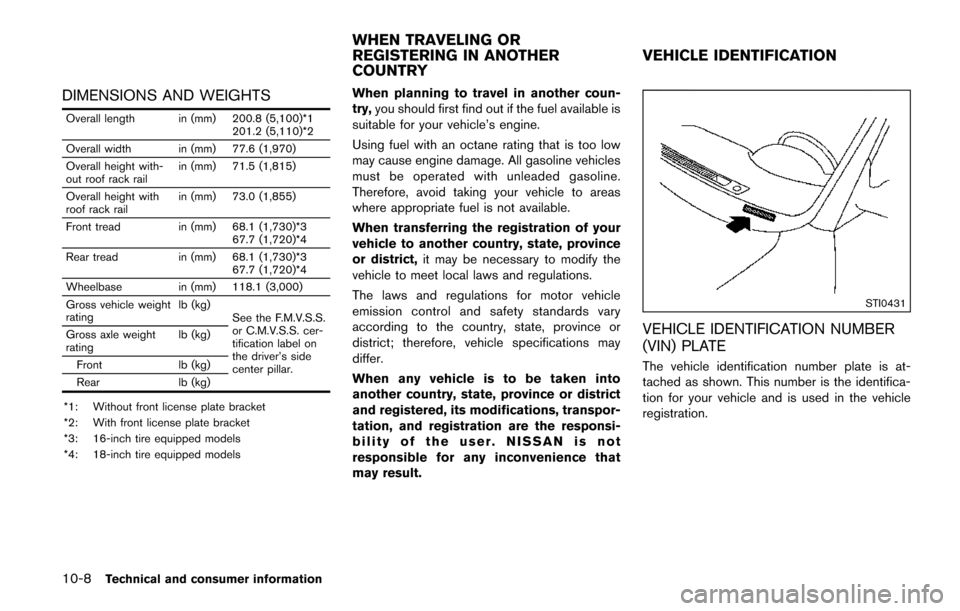
10-8Technical and consumer information
DIMENSIONS AND WEIGHTS
Overall length in (mm) 200.8 (5,100)*1201.2 (5,110)*2
Overall width in (mm) 77.6 (1,970)
Overall height with-
out roof rack rail in (mm) 71.5 (1,815)
Overall height with
roof rack rail in (mm) 73.0 (1,855)
Front tread in (mm) 68.1 (1,730)*3 67.7 (1,720)*4
Rear tread in (mm) 68.1 (1,730)*3 67.7 (1,720)*4
Wheelbase in (mm) 118.1 (3,000)
Gross vehicle weight
rating lb (kg)
See the F.M.V.S.S.
or C.M.V.S.S. cer-
tification label on
the driver’s side
center pillar.
Gross axle weight
rating
lb (kg)
Front lb (kg)
Rear lb (kg)
*1: Without front license plate bracket
*2: With front license plate bracket
*3: 16-inch tire equipped models
*4: 18-inch tire equipped models
When planning to travel in another coun-
try, you should first find out if the fuel available is
suitable for your vehicle’s engine.
Using fuel with an octane rating that is too low
may cause engine damage. All gasoline vehicles
must be operated with unleaded gasoline.
Therefore, avoid taking your vehicle to areas
where appropriate fuel is not available.
When transferring the registration of your
vehicle to another country, state, province
or district, it may be necessary to modify the
vehicle to meet local laws and regulations.
The laws and regulations for motor vehicle
emission control and safety standards vary
according to the country, state, province or
district; therefore, vehicle specifications may
differ.
When any vehicle is to be taken into
another country, state, province or district
and registered, its modifications, transpor-
tation, and registration are the responsi-
bility of the user. NISSAN is not
responsible for any inconvenience that
may result.
STI0431
VEHICLE IDENTIFICATION NUMBER
(VIN) PLATE
The vehicle identification number plate is at-
tached as shown. This number is the identifica-
tion for your vehicle and is used in the vehicle
registration.
WHEN TRAVELING OR
REGISTERING IN ANOTHER
COUNTRY VEHICLE IDENTIFICATION
Page 498 of 520
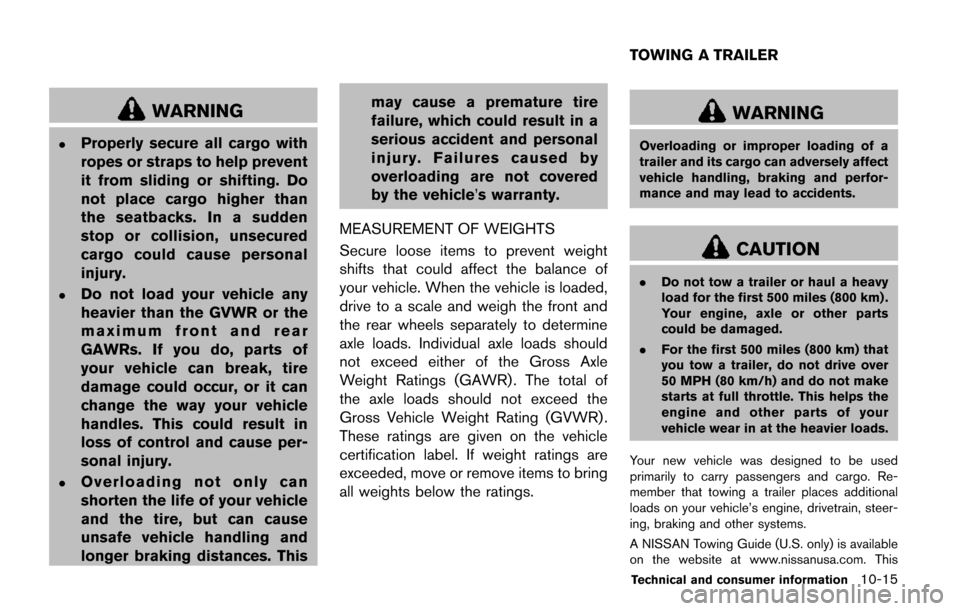
WARNING
.Properly secure all cargo with
ropes or straps to help prevent
it from sliding or shifting. Do
not place cargo higher than
the seatbacks. In a sudden
stop or collision, unsecured
cargo could cause personal
injury.
.Do not load your vehicle any
heavier than the GVWR or the
maximum front and rear
GAWRs. If you do, parts of
your vehicle can break, tire
damage could occur, or it can
change the way your vehicle
handles. This could result in
loss of control and cause per-
sonal injury.
.Overloading not only can
shorten the life of your vehicle
and the tire, but can cause
unsafe vehicle handling and
longer braking distances. Thismay cause a premature tire
failure, which could result in a
serious accident and personal
injury. Failures caused by
overloading are not covered
by the vehicle’s warranty.
MEASUREMENT OF WEIGHTS
Secure loose items to prevent weight
shifts that could affect the balance of
your vehicle. When the vehicle is loaded,
drive to a scale and weigh the front and
the rear wheels separately to determine
axle loads. Individual axle loads should
not exceed either of the Gross Axle
Weight Ratings (GAWR) . The total of
the axle loads should not exceed the
Gross Vehicle Weight Rating (GVWR) .
These ratings are given on the vehicle
certification label. If weight ratings are
exceeded, move or remove items to bring
all weights below the ratings.
WARNING
Overloading or improper loading of a
trailer and its cargo can adversely affect
vehicle handling, braking and perfor-
mance and may lead to accidents.
CAUTION
. Do not tow a trailer or haul a heavy
load for the first 500 miles (800 km) .
Your engine, axle or other parts
could be damaged.
. For the first 500 miles (800 km) that
you tow a trailer, do not drive over
50 MPH (80 km/h) and do not make
starts at full throttle. This helps the
engine and other parts of your
vehicle wear in at the heavier loads.
Your new vehicle was designed to be used
primarily to carry passengers and cargo. Re-
member that towing a trailer places additional
loads on your vehicle’s engine, drivetrain, steer-
ing, braking and other systems.
A NISSAN Towing Guide (U.S. only) is available
on the website at www.nissanusa.com. This
Technical and consumer information10-15
TOWING A TRAILER
Page 505 of 520
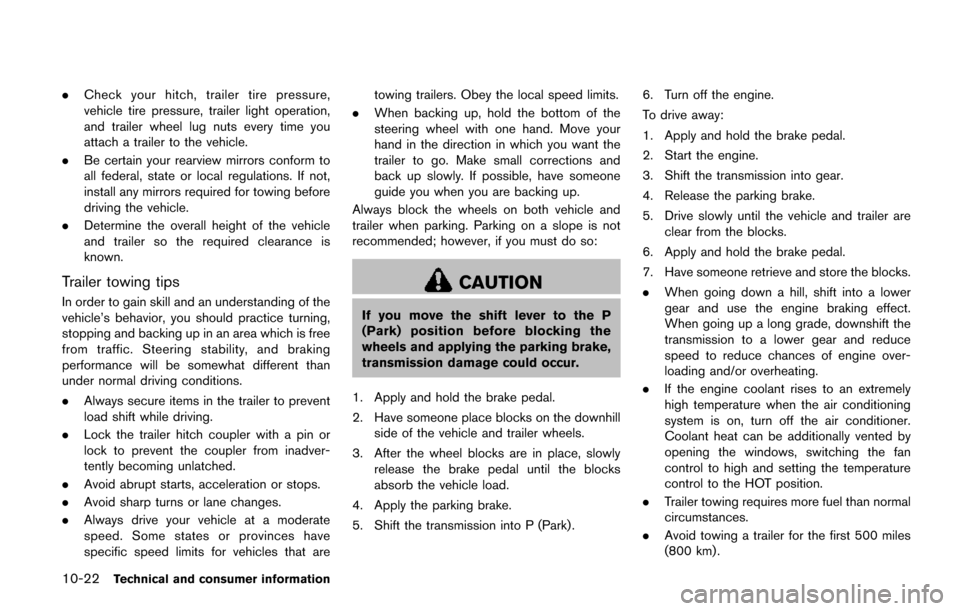
10-22Technical and consumer information
.Check your hitch, trailer tire pressure,
vehicle tire pressure, trailer light operation,
and trailer wheel lug nuts every time you
attach a trailer to the vehicle.
. Be certain your rearview mirrors conform to
all federal, state or local regulations. If not,
install any mirrors required for towing before
driving the vehicle.
. Determine the overall height of the vehicle
and trailer so the required clearance is
known.
Trailer towing tips
In order to gain skill and an understanding of the
vehicle’s behavior, you should practice turning,
stopping and backing up in an area which is free
from traffic. Steering stability, and braking
performance will be somewhat different than
under normal driving conditions.
.Always secure items in the trailer to prevent
load shift while driving.
. Lock the trailer hitch coupler with a pin or
lock to prevent the coupler from inadver-
tently becoming unlatched.
. Avoid abrupt starts, acceleration or stops.
. Avoid sharp turns or lane changes.
. Always drive your vehicle at a moderate
speed. Some states or provinces have
specific speed limits for vehicles that are towing trailers. Obey the local speed limits.
. When backing up, hold the bottom of the
steering wheel with one hand. Move your
hand in the direction in which you want the
trailer to go. Make small corrections and
back up slowly. If possible, have someone
guide you when you are backing up.
Always block the wheels on both vehicle and
trailer when parking. Parking on a slope is not
recommended; however, if you must do so:
CAUTION
If you move the shift lever to the P
(Park) position before blocking the
wheels and applying the parking brake,
transmission damage could occur.
1. Apply and hold the brake pedal.
2. Have someone place blocks on the downhill side of the vehicle and trailer wheels.
3. After the wheel blocks are in place, slowly release the brake pedal until the blocks
absorb the vehicle load.
4. Apply the parking brake.
5. Shift the transmission into P (Park) . 6. Turn off the engine.
To drive away:
1. Apply and hold the brake pedal.
2. Start the engine.
3. Shift the transmission into gear.
4. Release the parking brake.
5. Drive slowly until the vehicle and trailer are
clear from the blocks.
6. Apply and hold the brake pedal.
7. Have someone retrieve and store the blocks.
. When going down a hill, shift into a lower
gear and use the engine braking effect.
When going up a long grade, downshift the
transmission to a lower gear and reduce
speed to reduce chances of engine over-
loading and/or overheating.
. If the engine coolant rises to an extremely
high temperature when the air conditioning
system is on, turn off the air conditioner.
Coolant heat can be additionally vented by
opening the windows, switching the fan
control to high and setting the temperature
control to the HOT position.
. Trailer towing requires more fuel than normal
circumstances.
. Avoid towing a trailer for the first 500 miles
(800 km) .
Page 506 of 520
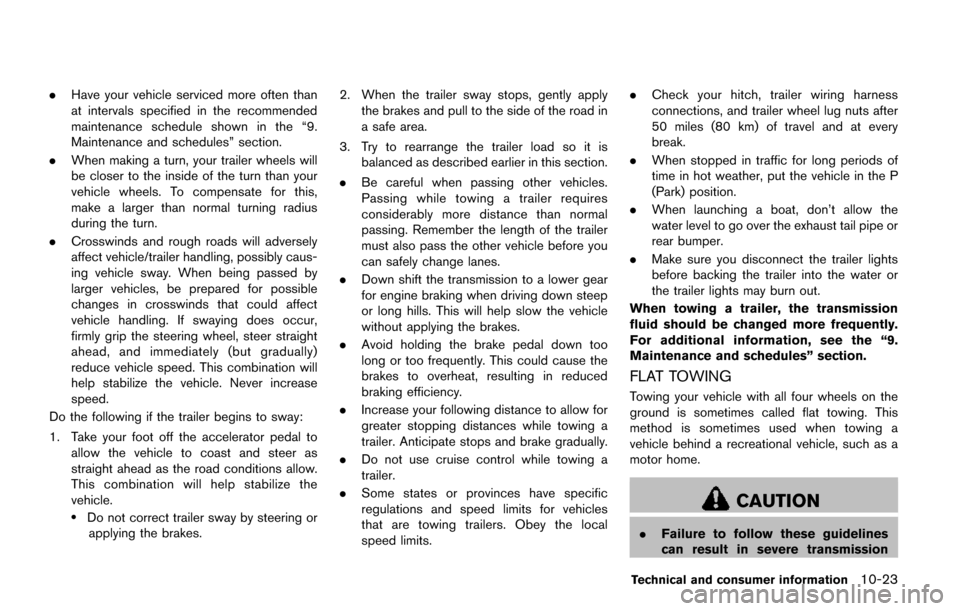
.Have your vehicle serviced more often than
at intervals specified in the recommended
maintenance schedule shown in the “9.
Maintenance and schedules” section.
. When making a turn, your trailer wheels will
be closer to the inside of the turn than your
vehicle wheels. To compensate for this,
make a larger than normal turning radius
during the turn.
. Crosswinds and rough roads will adversely
affect vehicle/trailer handling, possibly caus-
ing vehicle sway. When being passed by
larger vehicles, be prepared for possible
changes in crosswinds that could affect
vehicle handling. If swaying does occur,
firmly grip the steering wheel, steer straight
ahead, and immediately (but gradually)
reduce vehicle speed. This combination will
help stabilize the vehicle. Never increase
speed.
Do the following if the trailer begins to sway:
1. Take your foot off the accelerator pedal to allow the vehicle to coast and steer as
straight ahead as the road conditions allow.
This combination will help stabilize the
vehicle.
.Do not correct trailer sway by steering orapplying the brakes. 2. When the trailer sway stops, gently apply
the brakes and pull to the side of the road in
a safe area.
3. Try to rearrange the trailer load so it is balanced as described earlier in this section.
. Be careful when passing other vehicles.
Passing while towing a trailer requires
considerably more distance than normal
passing. Remember the length of the trailer
must also pass the other vehicle before you
can safely change lanes.
. Down shift the transmission to a lower gear
for engine braking when driving down steep
or long hills. This will help slow the vehicle
without applying the brakes.
. Avoid holding the brake pedal down too
long or too frequently. This could cause the
brakes to overheat, resulting in reduced
braking efficiency.
. Increase your following distance to allow for
greater stopping distances while towing a
trailer. Anticipate stops and brake gradually.
. Do not use cruise control while towing a
trailer.
. Some states or provinces have specific
regulations and speed limits for vehicles
that are towing trailers. Obey the local
speed limits. .
Check your hitch, trailer wiring harness
connections, and trailer wheel lug nuts after
50 miles (80 km) of travel and at every
break.
. When stopped in traffic for long periods of
time in hot weather, put the vehicle in the P
(Park) position.
. When launching a boat, don’t allow the
water level to go over the exhaust tail pipe or
rear bumper.
. Make sure you disconnect the trailer lights
before backing the trailer into the water or
the trailer lights may burn out.
When towing a trailer, the transmission
fluid should be changed more frequently.
For additional information, see the “9.
Maintenance and schedules” section.
FLAT TOWING
Towing your vehicle with all four wheels on the
ground is sometimes called flat towing. This
method is sometimes used when towing a
vehicle behind a recreational vehicle, such as a
motor home.
CAUTION
. Failure to follow these guidelines
can result in severe transmission
Technical and consumer information10-23
Page 507 of 520
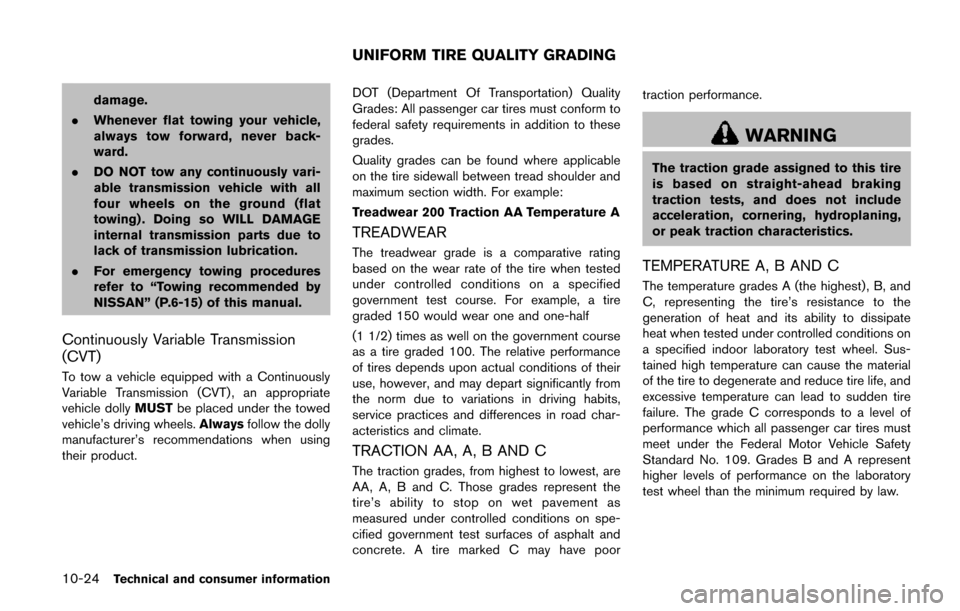
10-24Technical and consumer information
damage.
. Whenever flat towing your vehicle,
always tow forward, never back-
ward.
. DO NOT tow any continuously vari-
able transmission vehicle with all
four wheels on the ground (flat
towing) . Doing so WILL DAMAGE
internal transmission parts due to
lack of transmission lubrication.
. For emergency towing procedures
refer to “Towing recommended by
NISSAN” (P.6-15) of this manual.
Continuously Variable Transmission
(CVT)
To tow a vehicle equipped with a Continuously
Variable Transmission (CVT) , an appropriate
vehicle dolly MUSTbe placed under the towed
vehicle’s driving wheels. Alwaysfollow the dolly
manufacturer’s recommendations when using
their product. DOT (Department Of Transportation) Quality
Grades: All passenger car tires must conform to
federal safety requirements in addition to these
grades.
Quality grades can be found where applicable
on the tire sidewall between tread shoulder and
maximum section width. For example:
Treadwear 200 Traction AA Temperature A
TREADWEAR
The treadwear grade is a comparative rating
based on the wear rate of the tire when tested
under controlled conditions on a specified
government test course. For example, a tire
graded 150 would wear one and one-half
(1 1/2) times as well on the government course
as a tire graded 100. The relative performance
of tires depends upon actual conditions of their
use, however, and may depart significantly from
the norm due to variations in driving habits,
service practices and differences in road char-
acteristics and climate.
TRACTION AA, A, B AND C
The traction grades, from highest to lowest, are
AA, A, B and C. Those grades represent the
tire’s ability to stop on wet pavement as
measured under controlled conditions on spe-
cified government test surfaces of asphalt and
concrete. A tire marked C may have poortraction performance.
WARNING
The traction grade assigned to this tire
is based on straight-ahead braking
traction tests, and does not include
acceleration, cornering, hydroplaning,
or peak traction characteristics.
TEMPERATURE A, B AND C
The temperature grades A (the highest) , B, and
C, representing the tire’s resistance to the
generation of heat and its ability to dissipate
heat when tested under controlled conditions on
a specified indoor laboratory test wheel. Sus-
tained high temperature can cause the material
of the tire to degenerate and reduce tire life, and
excessive temperature can lead to sudden tire
failure. The grade C corresponds to a level of
performance which all passenger car tires must
meet under the Federal Motor Vehicle Safety
Standard No. 109. Grades B and A represent
higher levels of performance on the laboratory
test wheel than the minimum required by law.
UNIFORM TIRE QUALITY GRADING
Page 512 of 520
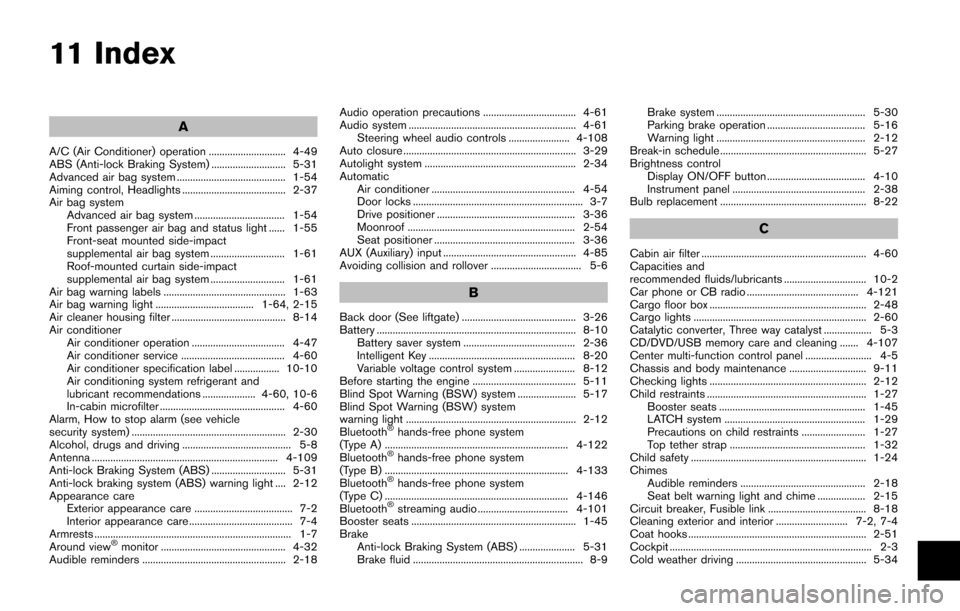
11 Index
A
A/C (Air Conditioner) operation ............................. 4-49
ABS (Anti-lock Braking System) ............................ 5-31
Advanced air bag system ......................................... 1-54
Aiming control, Headlights ....................................... 2-37
Air bag systemAdvanced air bag system .................................. 1-54
Front passenger air bag and status light ...... 1-55
Front-seat mounted side-impact
supplemental air bag system ............................ 1-61
Roof-mounted curtain side-impact
supplemental air bag system ............................ 1-61
Air bag warning labels .............................................. 1-63
Air bag warning light ..................................... 1-64, 2-15
Air cleaner housing filter ........................................... 8-14
Air conditioner Air conditioner operation ................................... 4-47
Air conditioner service ....................................... 4-60
Air conditioner specification label ................. 10-10
Air conditioning system refrigerant and
lubricant recommendations .................... 4-60, 10-6
In-cabin microfilter ............................................... 4-60
Alarm, How to stop alarm (see vehicle
security system) .......................................................... 2-30
Alcohol, drugs and driving ......................................... 5-8
Antenna ...................................................................... 4-109
Anti-lock Braking System (ABS) ............................ 5-31
Anti-lock braking system (ABS) warning light .... 2-12
Appearance care Exterior appearance care ..................................... 7-2
Interior appearance care ....................................... 7-4
Armrests .......................................................................... 1-7
Around view
�Šmonitor ............................................... 4-32
Audible reminders ...................................................... 2-18 Audio operation precautions ................................... 4-61
Audio system ............................................................... 4-61
Steering wheel audio controls ....................... 4-108
Auto closure ................................................................. 3-29
Autolight system ......................................................... 2-34
Automatic Air conditioner ...................................................... 4-54
Door locks ................................................................ 3-7
Drive positioner .................................................... 3-36
Moonroof ............................................................... 2-54
Seat positioner ..................................................... 3-36
AUX (Auxiliary) input .................................................. 4-85
Avoiding collision and rollover .................................. 5-6
B
Back door (See liftgate) ........................................... 3-26
Battery ........................................................................... 8-10 Battery saver system .......................................... 2-36
Intelligent Key ....................................................... 8-20
Variable voltage control system ....................... 8-12
Before starting the engine ....................................... 5-11
Blind Spot Warning (BSW) system ...................... 5-17
Blind Spot Warning (BSW) system
warning light ................................................................ 2-12
Bluetooth
�Šhands-free phone system
(Type A) ..................................................................... 4-122
Bluetooth
�Šhands-free phone system
(Type B) ..................................................................... 4-133
Bluetooth
�Šhands-free phone system
(Type C) ..................................................................... 4-146
Bluetooth
�Šstreaming audio .................................. 4-101
Booster seats .............................................................. 1-45
Brake
Anti-lock Braking System (ABS) ..................... 5-31
Brake fluid ................................................................ 8-9 Brake system ........................................................ 5-30
Parking brake operation ..................................... 5-16
Warning light ........................................................ 2-12
Break-in schedule ....................................................... 5-27
Brightness control Display ON/OFF button ..................................... 4-10
Instrument panel .................................................. 2-38
Bulb replacement ....................................................... 8-22
C
Cabin air filter .............................................................. 4-60
Capacities and
recommended fluids/lubricants ............................... 10-2
Car phone or CB radio .......................................... 4-121
Cargo floor box ........................................................... 2-48
Cargo lights ................................................................. 2-60
Catalytic converter, Three way catalyst .................. 5-3
CD/DVD/USB memory care and cleaning ....... 4-107
Center multi-function control panel ......................... 4-5
Chassis and body maintenance ............................. 9-11
Checking lights ........................................................... 2-12
Child restraints ............................................................ 1-27 Booster seats ....................................................... 1-45
LATCH system ..................................................... 1-29
Precautions on child restraints ........................ 1-27
Top tether strap ................................................... 1-32
Child safety .................................................................. 1-24
Chimes Audible reminders ............................................... 2-18
Seat belt warning light and chime .................. 2-15
Circuit breaker, Fusible link ..................................... 8-18
Cleaning exterior and interior ........................... 7-2, 7-4
Coat hooks ................................................................... 2-51
Cockpit ............................................................................ 2-3
Cold weather driving ................................................. 5-34
Page 516 of 520
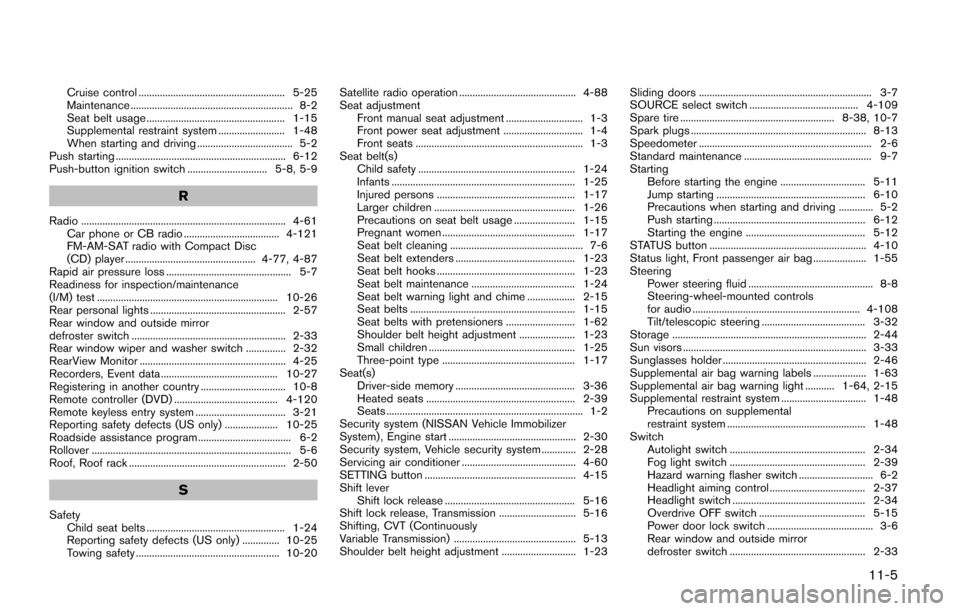
Cruise control ....................................................... 5-25
Maintenance ............................................................. 8-2
Seat belt usage .................................................... 1-15
Supplemental restraint system ......................... 1-48
When starting and driving .................................... 5-2
Push starting ................................................................ 6-12
Push-button ignition switch .............................. 5-8, 5-9
R
Radio ............................................................................. 4-61 Car phone or CB radio .................................... 4-121
FM-AM-SAT radio with Compact Disc
(CD) player ................................................. 4-77, 4-87
Rapid air pressure loss ............................................... 5-7
Readiness for inspection/maintenance
(I/M) test .................................................................... 10-26
Rear personal lights ................................................... 2-57
Rear window and outside mirror
defroster switch .......................................................... 2-33
Rear window wiper and washer switch ............... 2-32
RearView Monitor ....................................................... 4-25
Recorders, Event data ............................................ 10-27
Registering in another country ................................ 10-8
Remote controller (DVD) ....................................... 4-120
Remote keyless entry system .................................. 3-21
Reporting safety defects (US only) .................... 10-25
Roadside assistance program ................................... 6-2
Rollover ........................................................................... 5-6
Roof, Roof rack ........................................................... 2-50
S
Safety Child seat belts .................................................... 1-24
Reporting safety defects (US only) .............. 10-25
Towing safety ...................................................... 10-20 Satellite radio operation ............................................ 4-88
Seat adjustment
Front manual seat adjustment ............................. 1-3
Front power seat adjustment .............................. 1-4
Front seats ............................................................... 1-3
Seat belt(s) Child safety ........................................................... 1-24
Infants ..................................................................... 1-25
Injured persons .................................................... 1-17
Larger children ..................................................... 1-26
Precautions on seat belt usage ....................... 1-15
Pregnant women .................................................. 1-17
Seat belt cleaning .................................................. 7-6
Seat belt extenders ............................................. 1-23
Seat belt hooks .................................................... 1-23
Seat belt maintenance ....................................... 1-24
Seat belt warning light and chime .................. 2-15
Seat belts .............................................................. 1-15
Seat belts with pretensioners .......................... 1-62
Shoulder belt height adjustment ..................... 1-23
Small children ....................................................... 1-25
Three-point type .................................................. 1-17
Seat(s) Driver-side memory ............................................. 3-36
Heated seats ........................................................ 2-39
Seats .......................................................................... 1-2
Security system (NISSAN Vehicle Immobilizer
System) , Engine start ................................................ 2-30
Security system, Vehicle security system ............. 2-28
Servicing air conditioner ........................................... 4-60
SETTING button ......................................................... 4-15
Shift lever Shift lock release ................................................. 5-16
Shift lock release, Transmission ............................. 5-16
Shifting, CVT (Continuously
Variable Transmission) .............................................. 5-13
Shoulder belt height adjustment ............................ 1-23 Sliding doors ................................................................. 3-7
SOURCE select switch ......................................... 4-109
Spare tire .......................................................... 8-38, 10-7
Spark plugs .................................................................. 8-13
Speedometer ................................................................. 2-6
Standard maintenance ................................................ 9-7
Starting
Before starting the engine ................................ 5-11
Jump starting ........................................................ 6-10
Precautions when starting and driving ............. 5-2
Push starting ......................................................... 6-12
Starting the engine ............................................. 5-12
STATUS button ........................................................... 4-10
Status light, Front passenger air bag .................... 1-55
Steering Power steering fluid ............................................... 8-8
Steering-wheel-mounted controls
for audio ............................................................... 4-108
Tilt/telescopic steering ....................................... 3-32
Storage ......................................................................... 2-44
Sun visors ..................................................................... 3-33
Sunglasses holder ...................................................... 2-46
Supplemental air bag warning labels .................... 1-63
Supplemental air bag warning light ........... 1-64, 2-15
Supplemental restraint system ................................ 1-48 Precautions on supplemental
restraint system .................................................... 1-48
Switch Autolight switch ................................................... 2-34
Fog light switch ................................................... 2-39
Hazard warning flasher switch ............................ 6-2
Headlight aiming control .................................... 2-37
Headlight switch .................................................. 2-34
Overdrive OFF switch ........................................ 5-15
Power door lock switch ........................................ 3-6
Rear window and outside mirror
defroster switch ................................................... 2-33
11-5
Page 517 of 520
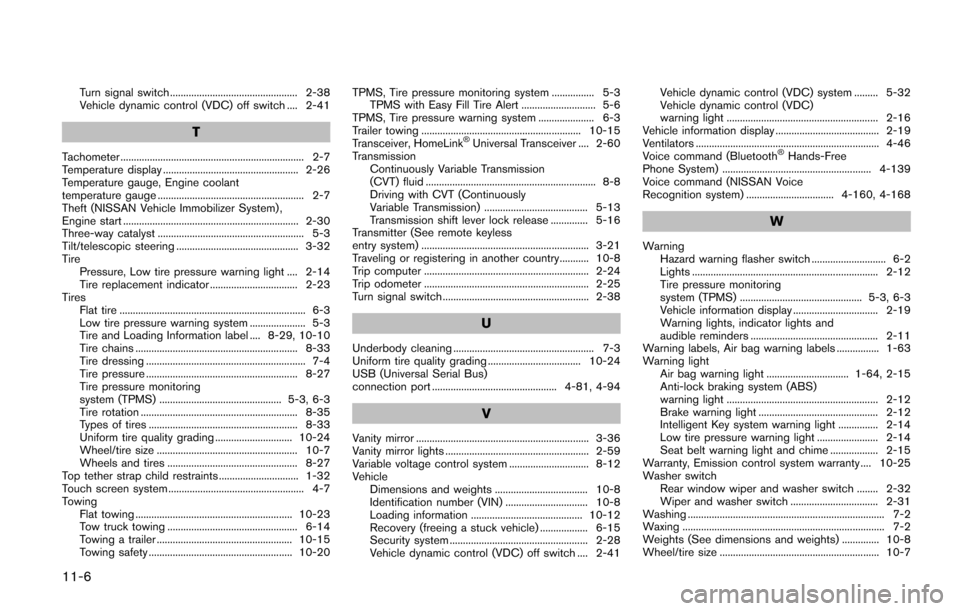
11-6
Turn signal switch ................................................ 2-38
Vehicle dynamic control (VDC) off switch .... 2-41
T
Tachometer ..................................................................... 2-7
Temperature display ................................................... 2-26
Temperature gauge, Engine coolant
temperature gauge ....................................................... 2-7
Theft (NISSAN Vehicle Immobilizer System) ,
Engine start .................................................................. 2-30
Three-way catalyst ....................................................... 5-3
Tilt/telescopic steering .............................................. 3-32
TirePressure, Low tire pressure warning light .... 2-14
Tire replacement indicator ................................. 2-23
Tires Flat tire ...................................................................... 6-3
Low tire pressure warning system ..................... 5-3
Tire and Loading Information label .... 8-29, 10-10
Tire chains ............................................................. 8-33
Tire dressing ............................................................ 7-4
Tire pressure ......................................................... 8-27
Tire pressure monitoring
system (TPMS) .............................................. 5-3, 6-3
Tire rotation ........................................................... 8-35
Types of tires ........................................................ 8-33
Uniform tire quality grading ............................. 10-24
Wheel/tire size ..................................................... 10-7
Wheels and tires ................................................. 8-27
Top tether strap child restraints .............................. 1-32
Touch screen system ................................................... 4-7
Towing Flat towing ........................................................... 10-23
Tow truck towing ................................................. 6-14
Towing a trailer ................................................... 10-15
Towing safety ...................................................... 10-20 TPMS, Tire pressure monitoring system ................ 5-3
TPMS with Easy Fill Tire Alert ............................ 5-6
TPMS, Tire pressure warning system ..................... 6-3
Trailer towing ............................................................ 10-15
Transceiver, HomeLink
�ŠUniversal Transceiver .... 2-60
Transmission Continuously Variable Transmission
(CVT) fluid ................................................................ 8-8
Driving with CVT (Continuously
Variable Transmission) ....................................... 5-13
Transmission shift lever lock release .............. 5-16
Transmitter (See remote keyless
entry system) ............................................................... 3-21
Traveling or registering in another country........... 10-8
Trip computer .............................................................. 2-24
Trip odometer .............................................................. 2-25
Turn signal switch ....................................................... 2-38
U
Underbody cleaning ..................................................... 7-3
Uniform tire quality grading ................................... 10-24
USB (Universal Serial Bus)
connection port ............................................... 4-81, 4-94
V
Vanity mirror ................................................................. 3-36
Vanity mirror lights ...................................................... 2-59
Variable voltage control system .............................. 8-12
Vehicle Dimensions and weights ................................... 10-8
Identification number (VIN) ............................... 10-8
Loading information .......................................... 10-12
Recovery (freeing a stuck vehicle) .................. 6-15
Security system .................................................... 2-28
Vehicle dynamic control (VDC) off switch .... 2-41 Vehicle dynamic control (VDC) system ......... 5-32
Vehicle dynamic control (VDC)
warning light ......................................................... 2-16
Vehicle information display ....................................... 2-19
Ventilators ..................................................................... 4-46
Voice command (Bluetooth
�ŠHands-Free
Phone System) ........................................................ 4-139
Voice command (NISSAN Voice
Recognition system) ................................. 4-160, 4-168
W
Warning Hazard warning flasher switch ............................ 6-2
Lights ...................................................................... 2-12
Tire pressure monitoring
system (TPMS) .............................................. 5-3, 6-3
Vehicle information display ................................ 2-19
Warning lights, indicator lights and
audible reminders ................................................ 2-11
Warning labels, Air bag warning labels ................ 1-63
Warning light
Air bag warning light ............................... 1-64, 2-15
Anti-lock braking system (ABS)
warning light ......................................................... 2-12
Brake warning light ............................................. 2-12
Intelligent Key system warning light ............... 2-14
Low tire pressure warning light ....................... 2-14
Seat belt warning light and chime .................. 2-15
Warranty, Emission control system warranty .... 10-25
Washer switch Rear window wiper and washer switch ........ 2-32
Wiper and washer switch ................................. 2-31
Washing .......................................................................... 7-2
Waxing ............................................................................ 7-2
Weights (See dimensions and weights) .............. 10-8
Wheel/tire size ............................................................ 10-7